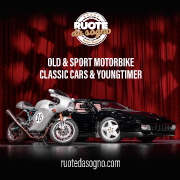Chassis No. 13357 Engine No. B 262 Ferrari publicly introduced the 365 GTB/4 “Daytona” in the autumn of 1968—but this announcement was preceded by three prototypes featuring varying design cues. While the first two prototypes, chassis 10287 and 11001, featured a frontal treatment resembling its 275 GTB/4 predecessor—exhibiting the classic oval eggcrate grille and covered headlamps—the final prototype and the definitive production model debuted a much more radical design. Penned by Leonardo Fioravanti, the Daytona’s Scaglietti-built body featured an expansive hood section that swept down into a wedge-shaped, full-width Plexiglas panel covering fixed headlights. This dramatic pinstripe effect extended into the side indicator assemblies and around the leading edges of the front wings—a now-iconic styling detail recently revived in Ferrari’s latest V12 flagship, the 12Cilindri. At the rear, a set-back cabin flowed into a steeply-raked fastback profile punctuated by a Kamm tail. The result was a stunning conclusion to a legendary lineage of short-block Colombo V12-powered Ferraris, and the last flagship model produced before Fiat assumed control of the production of Ferrari road cars in 1969. Unfortunately, the Daytona’s original Plexiglas nose treatment only enjoyed a brief moment in the sun before it became the target of the U.S. Federal Safety Standards of the late 1960s. Among other things, the new regulations resulted in the covered headlamp arrangement being replaced by paired retractable units in mid-1971—an alteration made in all markets for the sake of uniformity. Therefore, approximately 400 of 1,406 total GTB/4 and GTS/4 Daytonas produced—affectionately named “Plexi” Daytonas—are estimated to have left Maranello before the change took effect, made even more rare by the fact that some Plexi cars were later converted to a retractable configuration. This Belgian-delivery example, completed on 17 April 1970, is one of these desirable early Plexi Daytonas. Chassis number 13357 is further distinguished as one of a mere two examples finished in the exceedingly rare shade of Avorio (Ivory) paintwork according to Ferrari historian Marcel Massini, which was paired with a Beige Scuro Connolly leather interior. Chassis 13357 was delivered on 25 June 1970 to Jacques Swaters’ Garage Francorchamps SA in Brussels, selling later that year to first owner Baron Hughes “Hugh” de Fierlant. An extremely worthy first custodian, de Fierlant made his sports car racing debut earlier that year, piloting the Ferrari 512S of Écurie Francorchamps in the 1970 1000 Km of Spa-Francorchamps, finishing 8th overall. That summer, he achieved his career-best result of 5th overall in the 1970 24 Hours of Le Mans—his first of seven appearances in the legendary endurance race. Following de Fierlant’s ownership, the car passed to its second Belgian owner in the early 1980s—a member of Ferrari Club Belgio and the Daytona’s sole caretaker for the next three decades. In this ownership, chassis 13357 was restored in 2006 by Carrozzeria Francorchamps in Zaventem, Belgium, which saw the car refinished in red with a black interior. The berlinetta was subsequently submitted for Ferrari Classiche certification which it received in October 2011, with its “Red Book” noting that the car retains its original, matching-numbers Tipo 251 Colombo V12 engine and a correct-type transaxle. The car passed to the current caretaker in 2015, and after ten years of enjoyment, in early 2025, the Daytona was desirably returned to its original Avorio over Beige Scuro leather with Nero inserts under the supervision of Gipimotor in Evere, Belgium. The bare-metal respray was entrusted to Carrozzeria Piemontaise in Evere while a full re-trimming of the interior was undertaken by the artisans at Interni Auto Maieli in Mantua, Italy. Today, chassis 13357 emerges as one of the most compelling examples of Ferrari's iconic Daytona, combining the coveted early "Plexi" nose configuration with this exceptionally rare factory color combination—a specification shared by only one other example. With its matching-numbers engine, Ferrari Classiche certification, documented ownership by just three Belgian owners, and concours-level restoration to original specification, this Daytona exemplifies the perfect intersection of rarity, authenticity, and intriguing motorsport heritage in one of the most defining sports cars of the era.
- Fuel
- Body Types
- Transmission
- Exterior Colour
- Number of doors
- Interior Colour
- VIN Code13357





































































































